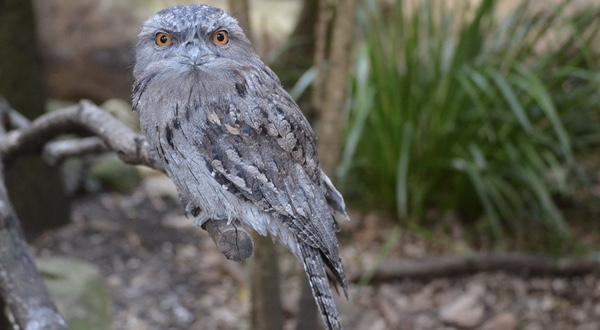ANIMAL: Tawny Frogmouth Podargus strigoides Type of Animal: Nightjar Habitat: Forests, woodland, scrubland, suburban/urban areas, parks, gardens, savanna, heathland, forest margins, timbered rivercourses, areas w/ river gums & casuarinas, golf courses, temperate grassland, shrubland Location(s): Australia & Tasmania Appearance: Brownish-grayish but chestnut or rufous coloration mixed in not uncommon, big owl-like heads, frog-like mouth, large yellow eyes, stocky compact body, wide hooked bristly beak yellowish to olive gray in color Food/Diet: Spiders, slugs, worms, snails, centipedes, insects, small mammals, birds, frogs, reptiles, scorpions, millipedes Status in Wild: Stable Conservation: Breeding in zoos, aquariums, & wildlife centers Lifestyle: Monogamous pairs or solitary Additional Info: Called: Male: Cock Female: Hen Young: Chick Group: Pair Weight: Male: 12.5 oz Female: 10.5 oz Young: 3.6 oz Gestation: 1 month Life Span: 10-14 years in wild, 20-30 years in captivity Height: Male: 1.73 ft Female: 1.12 ft Body Length: Male: 1.73 ft Female: 1.12 ft Tail Length: 8 in Main predators of adults are foxes, dogs, cats, pythons, crocodilians, & monitor lizards. Ravens, butcherbirds, currawongs, falcons, owls, goshawks, large rodents, & snakes take chicks. These birds are highly nocturnal. They obtain prey by sitting & waiting & using camouflage. Camouflage also protects them from predators. Pairs lay 1-3 eggs w/ male incubating during day & both parents incubating at night. Sexually mature at a year old. Hatchlings first open eyes at 10 days & start growing feathers at 20 days-fledge at around a month old & stay w/ parents for 1-6 months. Make loud drumming noises during breeding season. Has 2-3 ft wingspan. Tend to be shy & secretive in the wild. Highly beneficial due to habit of preying on invertebrates & rodents. Kill prey w/ beaks & quickly fly back to tree due to being more vulnerable to predators on ground. Usually breed from August-December. Fun Fact(s): When sensing danger, they erect head, close eyes, & freeze body creating impression of broken branch. Highly adaptable-in hot weather, they can triple breathing rate & engorge blood vessels allowing more oxygen into body. In colder periods, can slow heartrate/metabolism by going into torpor.

